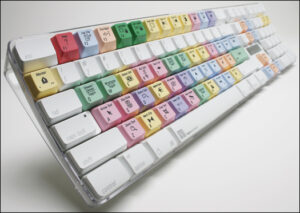Watching an editor edit can sometimes be like watching a speck of water evaporate from the table. It will feel that slow and yes boring. When working with an editor there are several things I’ve learned over the years, and one of them is never sit in the same room leaning over their shoulders waiting for them to make the next cut. It’s absolute torture for me and it’s probably annoying for the editor to have a producer tell them to shave five frames off the head of a dissolve while their still in the middle of cutting the piece. Geez… once the timeline is down the editor will need to go through it a few times and get a sense of the pacing, make their own changes and adjustments, select different shots without someone sitting behind them watching their every keystroke. Just imagine you’re in the middle of writing a script and someone behind you has a suggestion for every comma, preposition or adjective, while you’re still formulating your thoughts. You might just want to turn around and slap some sense into them.
Here’s how I work with editors –
Typically, I’ll string the time line together in FCP or Avid to get the story down. Then I’ll turn it over to the editor. At this point I’m very close to the story. I’ve written it, I’ve shot it, I’ve screened the material and I’ve created a rough cut. Time for some fresh, creative, professional eyes to take it to the next level and bring another dimension to the storytelling.
I’ll give the editor the script, my log sheets, notes, and footage that absolutely must be in the segment. If animation has been created, I’ll supply that as well, unless the editor is going to create them in After Effects. Once I hand everything over I walk away. Yes, walk away. Let him or her work with it like a sculptor with clay. Let them put their creative stamp on it, and see where it takes the piece. You can always pull back. But it takes longer to get something out of an editor if you’ve shut them down from the beginning by saying this is the way it has to be, no changes, no exceptions.
The other end of the spectrum is the producer who isn’t remotely prepared. The producer who simply hands over the raw footage and says, “Over to you.” This is just asking for trouble. It wastes time, money and will wear on most editor’s nerves. Why? Because an editor isn’t a mind reader. They haven’t been involved in all the discussions with the executives and the network. They don’t have the time and you don’t have the money for them to shuttle through all the footage making selects. It’s up to you the producer to screen the material before hand, make the selects, write down the time code that corresponds with the storyline or script and supply the editor with a ‘blueprint’ of what you want the story to say and where you want it to go.
Working with an editor is a fine line between having an opinion about every single cut and letting them spread their creative wings to help you create the best possible show or segment.
Be prepared, have a strong idea of what you want the show to say and then give the editor some space. Together you’ll create TV magic.




I think this is a great approach. I often have my students read Walter Murch and Ralph Rosenblum so they’ll understand how much that director / editor relationship can shape the editing process.
Hey Maria,
Having worked with you in the past, I know how you operate as a producer and as an editor I love your work ethic for working with editors.
Hope all is well.
James Castronuovo
Hi Ted – Thanks for the book recommendations. I’ll look them up.
James! Great to ‘see’ you. I think you’ve got terrific editing chops. I’d worked with you again, anytime, anywhere.
Excellent advice, Maria. Starting out as an editor myself, I can tell you the worst thing you can do to a good editor is to turn them into a “button pusher.” Micromanaging their every move is a bad way to go.
Like all roles in a production, the goal should be to hire an editor who can add to a project by collaborating, experimenting, and bringing something unique to a finished project. Tough to do with someone over your shoulder!
I have to remind myself of this now that I’m an Executive Producer. It’s tough not to just jump in and make changes myself. But using restraint in those situations almost always leads to a better, more sophisticated cut. Many times the editor surprises me with something I never even thought to try.
Great post!
Best,
Biagio
Twitter: @jokeandbiagio